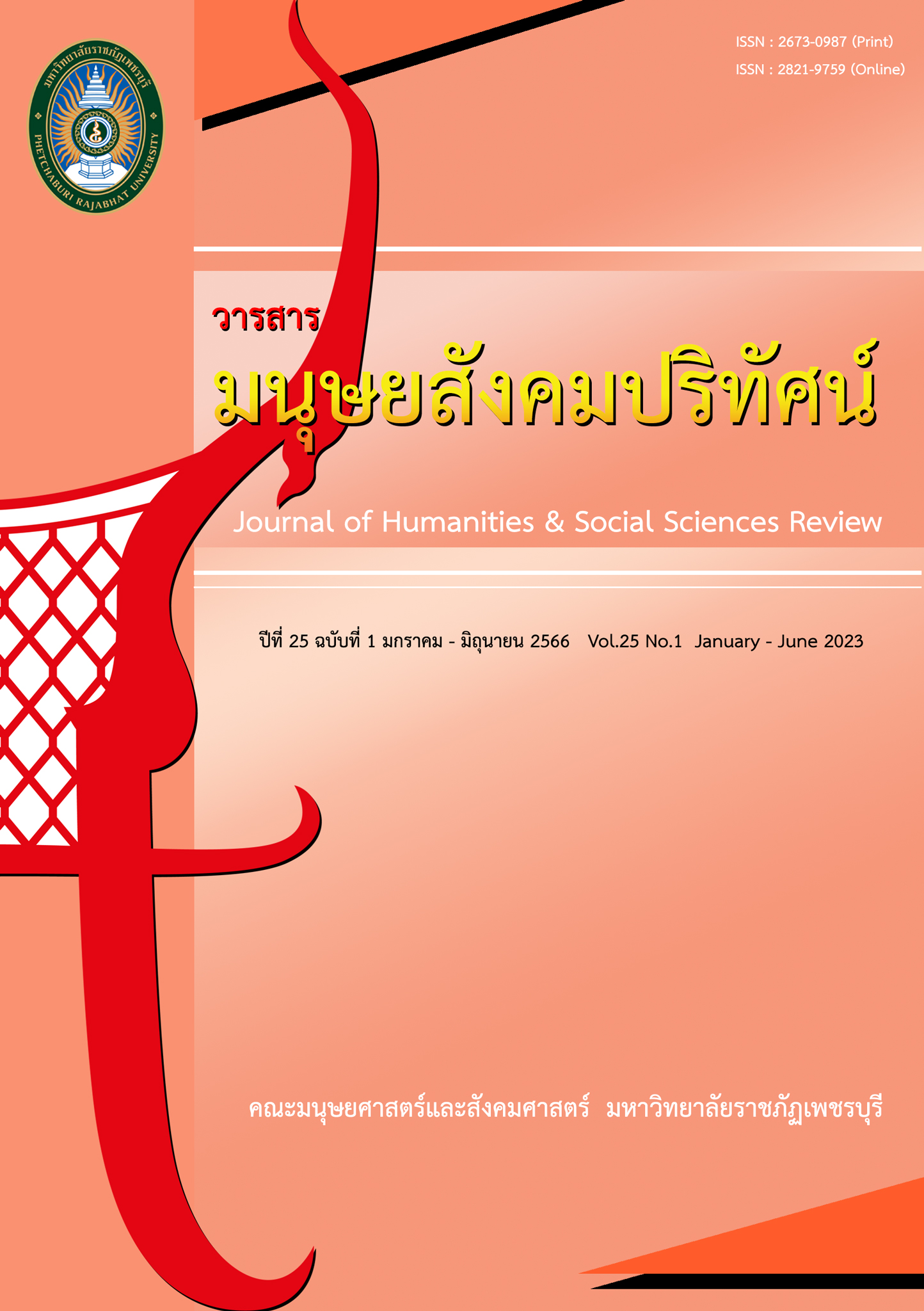Development of instructional model based on Active Learning concept to promote speaking ability for high school students
Main Article Content
Abstract
The purposes of this research were 1) to develop and find the quality of the teaching pattern by following the Active Learning idea for supporting the ability of presentation of high school students and 2) to evaluate the pattern of Active Learning for high school students. This research development was conducted from a case study involving students in the 12th grade at Khlongkhlungratpracharangsan School. The total amount of students in the first semester was 37 students. The simple method was used for teaching students with the presentation of Active Learning in high school. This simple method also contained knowledge of management. The evaluation of the student’s presentation and the student’s satisfaction data was collected from a standard deviation, one sample t-test, and content analysis in data analysis. The teaching model based on the concept of Active Learning to promote the ability to speak and present for high school students is called the “SPEAKS Model”. The principle of the model focused on improving learners' ability to speak and present through learning activities and on practical and thought-provoking presentations. There were teachers who gave advice, suggestion, encouragement, or facilitating which consisted of 6 steps: Step 1 drawing interest, step 2 solving problems, step 3 exploring and researching, step 4 analytical thinking, step 5 creatively presenting knowledge, and 6 assessing the learners. The result of the quality check of the model was found that it could be applied to the sample group. In the effectiveness of the model, it was found that after using the model, the student's ability to give presentations after learning was higher than the standard, statistically significant at the .05 and 2.2 levels. The students were satisfied with the overall developed model at a high level.
Article Details
1. Any views and comments in the article are the authors’ views. The editorial board has not to agree with those views and it is not considered as the editorial board’s responsibility. In case, there is any lawsuit about copyright infringement, it is considered as the authors’ sole responsibility.
2. The article copyright belonging to Faculty of Humanities and Social Sciences, Phetchaburi Rajabhat University are copyrighted legally. Republication must be received direct permission from the authors and Phetchaburi Rajabhat University in written form.
References
กมล การกุศล. (2529). ทักษะและความรู้ทางภาษาไทย. กรุงเทพฯ: เนติกุลการพิมพ์.
กมล โพธิเย็น. (2564). Active learning การจัดการเรียนรู้ที่ตอบโจทย์การจัดการศึกษาในศตวรรษที่ 21. วารสารศึกษาศาสตร์ มหาวิทยาลัยศิลปากร, 19(1): 11-28.
งามพริ้ง รุ่งโรจน์ดี. (2546). สบาย ๆ เมื่อจับไมค์พูดภาษาอังกฤษ (พิมพ์ครั้งที่ 2). กรุงเทพฯ: สมาคมส่งเสริมเทคโนโลยี (ไทย-ญี่ปุ่น).
จุราภรณ์ ปฐมวงษ์. (2565). การพัฒนารูปแบบการเรียนรู้เชิงรุก (Active Learning) เพื่อส่งเสริมทักษะการพูด สนทนาภาษาอังกฤษ สำหรับนักเรียนชั้นมัธยมศึกษาปีที่ 3. Journal of Modern Learning Development, 7(4): 143-159.
ฐนสจันทร์ วงศ์สุวรรณ. (2547). การพูดเพื่อการพัฒนาบุคลิกภาพ. กรุงเทพ ฯ: เทคนิค 19.
ดนุลดา จามจุรี. (2564). การออกแบบการเรียนรู้: แนวคิดและกระบวนการ (Learning design: Concept and process). กรุงเทพฯ: มหาวิทยาลัยศรีนครินทรวิโรฒ.
ดิเรก พรสีมา. (2559). การจัดการเรียนรู้สำหรับผู้เรียนในยุค Thailand 4.0. วารสารฉบับภาษาไทย สาขามนุษยศาสตร์ สังคมศาสตร์ และศิลปะ, 11(2): 2363-2380.
ทิศนา แขมมณี. (2564). ศาสตร์การสอน: องค์ความรู้เพื่อการจัดกระบวนการเรียนรู้ที่มีประสิทธิภาพ (พิมพ์ครั้งที่ 25). กรุงเทพฯ: สำนักพิมพ์แห่งจุฬาลงกรณ์มหาวิทยาลัย.
ธัญญาลักษณ์ สังข์แก้ว. (2552). การเปรียบเทียบผลสัมฤทธิ์การเขียนสรุปความของนักเรียนชั้นมัธยมศึกษาปีที่ 3 ที่สอน โดยวิธี KWL Plus. วิทยานิพนธ์ศึกษาศาสตรมหาบัณฑิต สาขาวิชาการสอนภาษาไทย มหาวิทยาลัยศิลปากร.
นิภาวรรณ นวาวัตน์. (2562). การพัฒนารูปแบบการสอนทักษะการพูดภาษาอังกฤษเพื่อการสื่อสารแบบเน้นภาระงานร่วมกับการใช้สื่อสังคมออนไลน์เพื่อเสริมสร้างความสามารถในการพูดภาษาอังกฤษสำหรับนักศึกษาปริญญาตรี. วิทยานิพนธ์ปรัชญาดุษฎีบัณฑิต สาขาวิชาหลักสูตรและการสอน (การสอนภาษาอังกฤษ) มหาวิทยาลัยศิลปากร.
พัทธพีร์ มะลิสุวรรณ. (2558). รูปแบบการสะท้อนตนด้วยมิตรวิพากษ์และการประเมินหลายทางบนสื่อสังคมออนไลน์ที่มีต่อการเห็นคุณค่าในตนเองและความสามารถในการพูดนำเสนอทางวิชาการของนิสิตระดับอุดมศึกษา. วิทยานิพนธ์ครุศาสตรดุษฎีบัณฑิต สาขาวิชาเทคโนโลยีและสื่อสารการศึกษา จุฬาลงกรณ์มหาวิทยาลัย.
เพ็ญพนอ พ่วงแพ. (2561). การพัฒนารูปแบบกิจกรรมการเรียนการสอนตามแนวทฤษฎีการสร้างความรู้ร่วมกับแนวคิด การจัดการเรียนรู้เชิงรุก เพื่อส่งเสริมสมรรถนะครูสังคมศึกษา สำหรับนักศึกษาวิชาชีพครู. วารสารวิชาการ Veridian E–Journal, Silpakorn University ฉบับภาษาไทย สาขามนุษยศาสตร์ สังคมศาสตร์ และศิลปะ, 11(2): 703-717.
มนตรี ดีโนนโพธิ์. (2564). การพัฒนาทักษะการพูดภาษาจีนเบื้องต้นด้วยกิจกรรมการเรียนรู้แบบเชิงรุก (Active Learning) สำหรับนักศึกษาสาขาวิชาภาษาจีน มหาวิทยาลัยราชภัฏจันทรเกษม. วารสารจันทรเกษมสาร, 27(1): 106-123.
มาเรียม นิลพันธุ์. (2558). วิธีวิจัยทางการศึกษา (พิมพ์ครั้งที่ 9). นครปฐม: ศูนย์วิจัยและพัฒนาทางการศึกษาคณะศึกษาศาสตร์ มหาวิทยาลัยศิลปากร.
วารินท์พร ฟันเฟื่องฟู. (2562). การจัดการเรียนรู้ Active Learning ให้สำเร็จ. วารสารวไลยอลงกรณ์ปริทัศน์ (มนุษยศาสตร์และสังคมศาสตร์), 9(1): 135-145.
วิริยะ ฤาชัยพาณิชย์. (2557). คู่มือการสอนเพื่อสร้างศตวรรษที่ 21. กรุงเทพฯ: ไทยวัฒนาพาณิช จำกัด.
_______. (2562). สอนสร้างสรรค์เรียนสนุกยุค 4.0+. กรุงเทพฯ: ซีเอ็ดยูเคชั่น.
ศุภักษร ฟองจางวาง และกอบสุข คงมนัส. (2559). การศึกษาองค์ประกอบของรูปแบบ การเรียนการสอนแบบผสมผสานโดยใช้การเรียนรู้แบบร่วมมือเรื่องการเขียน โปรแกรมขั้นพื้นฐานด้วยภาษาจาวาสคริปต์ สำหรับนักเรียนชั้นมัธยมศึกษา ปีที่ 3. วารสารวิชาการ Veridian E–Journal, Silpakorn University ฉบับภาษาไทย สาขามนุษยศาสตร์ สังคมศาสตร์ และศิลปะ, 9(3): 937-953.
สง่า วงค์ไชย. (2560). การพัฒนารูปแบบการเรียนการสอนโดยบูรณาการแนวการสอนที่เน้นภาษา วรรณกรรม และประสบการณ์เพื่อส่งเสริมความสามารถในการอ่านเพื่อความเข้าใจและเขียนสรุปความของนักศึกษาระดับปริญญาบัณฑิต. วิทยานิพนธ์ปรัชญาดุษฎีบัณฑิต สาขาวิชาหลักสูตรและการสอน (การสอนภาษาไทย) มหาวิทยาลัยศิลปากร.
สถาพร พฤฑฒิกุล. (2558). คุณภาพผู้เรียน เกิดจากกระบวนการเรียนรู้. สระแก้ว: คณะเทคโนโลยีการเกษตร มหาวิทยาลัยบูรพา วิทยาเขตสระแก้ว.
สมศักดิ์ เอี่ยมคงสี. (2561). การจัดการห้องเรียนในศตวรรษที่ 21. กรุงเทพฯ: ทริปเพิ้ล เอ็ด ดูเคชั่น.
สิริพัชร์ เจษฎาวิโรชน์. (2560). กระบวนการเรียนรู้แบบสร้างสรรค์เป็นฐานในกระบวนวิชา CEE2205 (ความคิดสร้างสรรค์สำหรับเด็ก). วารสารศึกษาศาสตร์ปริทัศน์, 32(2): 1-8.
อนงค์นาถ ทนันชัย. (2563). การใช้เทคนิคการจัดการเรียนรู้เชิงรุกเพื่อพัฒนาทักษะการนำเสนอของนักศึกษาในรายวิชาการนำเสนอผลงานทางธุรกิจ. วารสารวิชาการ คณะมนุษยศาสตร์และสังคมศาสตร์ มหาวิทยาลัยราชภัฏนครสวรรค์, 7(1): 48-63.
อุทุมพร ภักดีวงศ์. (2562). การพัฒนารูปแบบการเรียนการสอนภาษาอังกฤษ เพื่อส่งเสริมความผูกพันของผู้เรียนและความสามารถทางการอ่านและการเขียนภาษาอังกฤษของนักศึกษาระดับปริญญาตรี. กรุงเทพฯ: มหาวิทยาลัยธุรกิจบัณฑิตย์.
Gerlach, V.S., & Donald, E. (1971). Teaching and media: As system approach. New Jersey: Prentice Hall.
Iowa State University. (2005). Oral evaluation rubric. Retrieved March 6, 2016, from http://www.dartmouth. edu/~ssimon/files/Oral-reportrubric.pdf.
Kemp, J. E. (1985). The instructional design process. New York: Harper & Row Publishers.
Kibler, R.J. (1970). Behavioral objectives and instructional process. In Selected Reading For the introduction to the Teaching Profession. Edited by Milton Muse. pp. 44-53. n.p.: Allyn and Bacon.
Sharan, Y; & Sharan, S. (1992). Expanding cooperative learning through group investigations. New York: Teacher College, Columbia University.
Slavin, R.E. (1995). Cooperative learning theory research and practice (2nd ed). New Jersey: Prentice-Hall.
Stanford University of Education. (2015). What is performance-based assessment? Stanford, CA: Stanford University School of Education.


